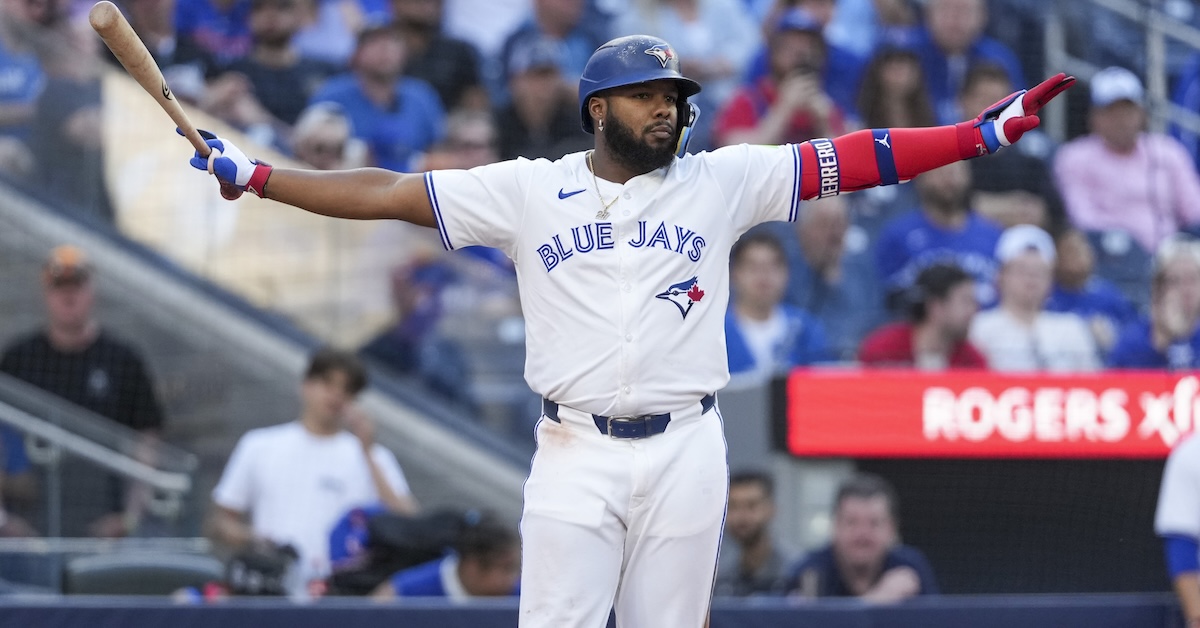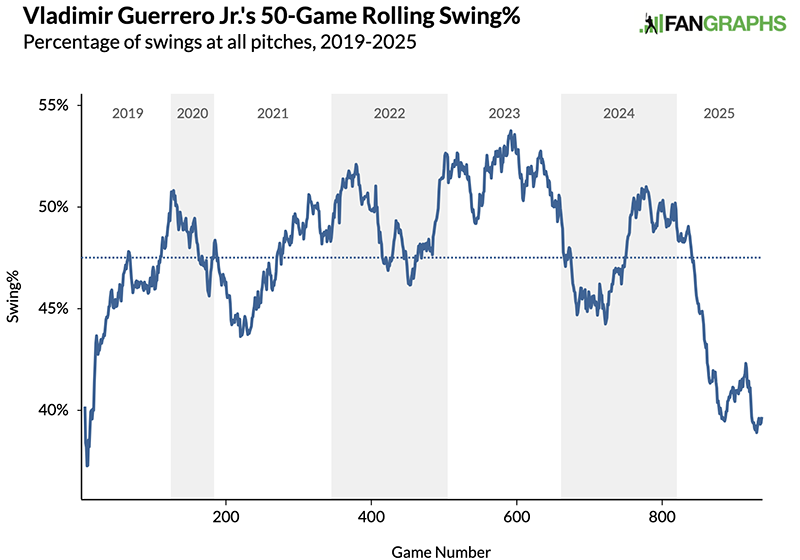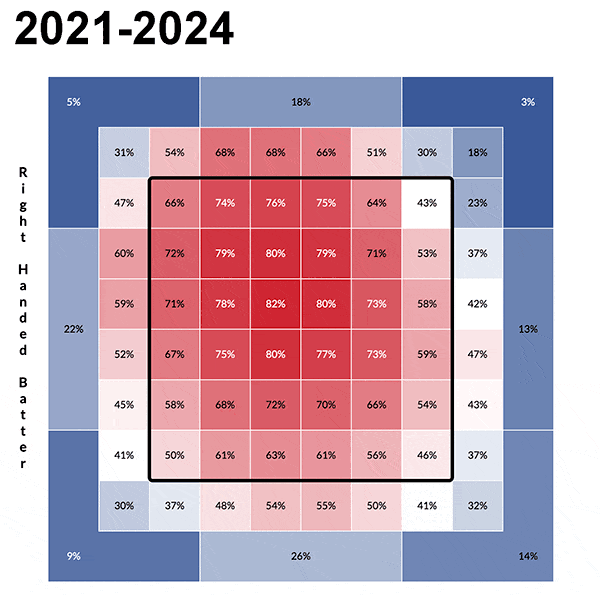Vladimir Guerrero Jr. Is Getting Out of the Swing of Things

We haven’t written much about Vladimir Guerrero Jr. since he signed his half-billion-dollar contract extension back in April. That’s understandable, in that we tend to write about new and exciting developments. Of course, the downside of that is sometimes it can lead us to neglect exciting players who aren’t necessarily doing anything new. On the surface, Guerrero very much falls into that category. He’s having a typical Vladimir Guerrero Jr. season.
| Season | wRC+ | AVG | HardHit | GB/FB |
|---|---|---|---|---|
| 2021-2024 | 145 | .293 | 52.4% | 1.41 |
| 2025 | 148 | .300 | 51.2% | 1.38 |
Those numbers are nearly identical! Guerrero is doing his thing, which consists of hitting the ball hard, hitting it on the ground, and putting up an overall batting line that should nab him a smattering of MVP votes. The Blue Jays promised Guerrero all the money in Canada in the hope that he would just keep on being himself for the next decade and a half, and he’s off to a great start. Just 14 more seasons like this to go. He’s on pace for 5.0 WAR, the third-best mark of his career. That’s certainly worth writing about, especially when Guerrero is doing it for the team with the best record in the American League. But also, I mostly want to write about this new thing he’s doing.
Here’s the new thing: Guerrero has stopped swinging. Not entirely – that would be silly – but he’s dropped his overall swing rate from 48.5% in 2024 all the way to 40.9% in 2025. That’s the third-largest decrease among all qualified players. It represents a huge departure for Guerrero (and an even bigger departure from the ways of his swing-happy father).

Guerrero is swinging less against all three groups of pitches – fastballs, breaking balls, and offspeed – and he’s swinging less against nearly every individual pitch type. (Damn you, slurves, for messing up a tidy narrative!) This is easy to see in the heat maps. Guerrero has always looked for the ball up in the zone, but he’s now specifically looking for pitches on the inner half, and he’s doing a much better job of laying off pitches at and below the bottom of the zone, especially sinkers.

Guerrero is also just swinging a lot less, though. The highest number in the 2025 heat map is 74%, right over the middle on the inner half. That would make it just the 11th-highest number on the 2021-2024 heat map. Guerrero was swinging more often at pitches at the very top of the strike zone than he is now at pitches right over the middle of the plate. It’s an extreme change.
Let’s start by looking at pitches out of the zone. Guerrero has never exactly been a free swinger, and he’s actually dropped his chase rate in each of the last three seasons, as Ben Nicholson-Smith of SportsNet noted back in May. At the time, Guerrero was at 24.6%, which was tied for the best mark of his entire career. He was just getting started. Over the two months since Nicholson-Smith’s observation, Guerrero has run a chase rate of 18.2%, sixth lowest of any player who’s seen at least 500 pitches over that stretch. It’s dropped his overall chase rate to 20.5%, which puts him in the 92nd percentile. Here’s what that looks like over the course of his career. That blue line started cratering after the All-Star break last season.

That’s pretty convincing. Only a few times in his entire career has Guerrero had a stretch with a lower chase rate than he’s run over the entire course of this season.
It’s great to lay off bad pitches. It earns you more balls, which puts you ahead in the count more often, which puts you in a position to succeed. And it hopefully means that more of your swings come on pitches where you can do real damage. But a couple of worries crop up any time you see a hitter dramatically drop their swing rate. You worry that they’ll take too many called strikes, offsetting the benefit of the extra balls. The trade-off might not be worth it. And you worry that they’ll be less aggressive, that if they’re not up there looking to attack the baseball, they’ll end up taking more hittable pitches, and they won’t do as much damage when they do swing.
Guerrero is indeed taking a lot more strikes. His 60.8% swing rate on pitches inside the zone is also a career low, and his 18% called strike rate is a career high. But the trade-off is working out great for two reasons. First, the fact that Guerrero is a fearsome slugger means that pitchers are afraid to pound the zone against him. Even though he’s running one of the lowest swing rates in the game, he still ranks right in the middle in terms of zone rate. The second is that Guerrero has drastically reduced his foul rate. He’s squaring the ball up more often and fouling off pitches on a career-low 31.5% of his swings. Put it all together, and a career-low 39.4% of the pitches he sees are ending up as strikes (or fouls), while a career-high 40.8% are ending up as balls. As a result, his 13.2% walk rate is the highest of his career; his 13.7% strikeout rate, the lowest. One of the game’s most feared power hitters is just four walks away from walking more than he’s striking out.
As for the second concern, Guerrero is definitely still attacking the baseball. His slugging percentage is a bit lower than usual, but certainly nothing that can’t be explained by the vagaries of batted ball luck. Robert Orr’s SEAGER metric, which rewards hitters for selective aggression, still has Guerrero in the 96th percentile. He’s lost some credit by taking more hittable pitches, but he’s made up for it by laying off bad pitches. His average bat speed is higher than it was in 2023 and 2024, and he’s meeting the ball farther out in front. His exit velocity numbers are right in line with his career marks, and he’s running a career-high line drive rate. So far this season, 24.4% of the pitches he’s seen over the heart of the plate have turned into hard-hit balls; over the past three seasons, that number was 24.3%. Guerrero’s xwOBACON – his expected performance when he puts the ball in play – is almost exactly the same as the number he posted last season. His overall batting line is a bit worse largely because the ball hasn’t found grass as often.
Altogether, Guerrero is walking more, striking out less, and hitting the ball pretty much as hard as he ever has. This would be a huge benefit for any batter. Adding a free 30 points to your on-base percentage is a big deal. It’s an especially big deal for a player like Guerrero, whose propensity for groundballs means that his production rarely lives up to the expectations you’d have from looking at his hard-hit rate alone.
When The Athletic’s Mitch Bannon asked about this new, more-patient Guerrero back in June, the Toronto coaching staff didn’t offer any earth-shattering insights. “Vlad’s not afraid to take his walks,” said manager John Schneider. “And we’re kind of seeing more and more of that. And we hope that it’s not the case, going forward you want him to swing the bat. But Vlad’s figured a lot of things out in a short amount of time.” New hitting coach David Popkins said, “I think he’s more aware of teams. Like how they’re pitching him and where they’re trying to pitch him.” Maybe Schneider and Popkins know more than they’re letting on, but this is coachspeak for shrugging your shoulders. Guerrero could be hitting the scouting reports harder; he could be seeing the ball better, or he could just be doing a better job of focusing on that middle-in pitch. Whatever the reason, this new version of Vladdy certainly looks just as dangerous as ever.
Davy Andrews is a Brooklyn-based musician and a writer at FanGraphs. He can be found on Bluesky @davyandrewsdavy.bsky.social.
Like father, unlike son?
Unlike father? Dislike son.